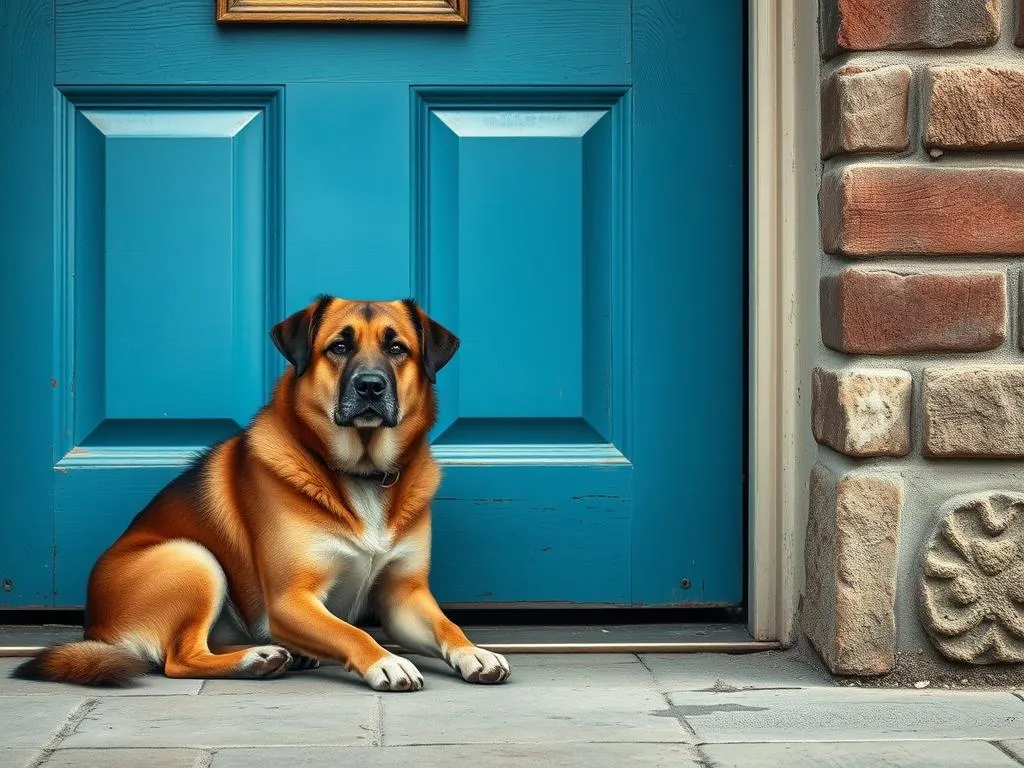
Every dog owner has likely experienced the moment when their furry friend plops down by the door, looking expectantly at the handle. Whether it’s a sunny day or a rainy afternoon, a dog sitting by the door can evoke a mixture of curiosity and concern. Why do dogs sit by the door? Understanding this behavior is crucial for better communication with our pets and for ensuring their needs are met.
Dogs are complex creatures with a rich tapestry of instincts and emotions. To interpret their actions, we must delve into their behavior, which often reveals their needs and desires. This article explores the reasons behind this common canine behavior and what it signifies about their emotional state.
Understanding Dog Behavior
The Instinctive Nature of Dogs
Dogs, as descendants of wolves, carry with them a wealth of instincts honed over thousands of years. These instincts play a significant role in their daily behaviors, including their tendency to guard territory and seek security. In the wild, wolves would often position themselves near their dens, keeping watch for intruders while ensuring their pack was safe. This instinctive behavior remains prevalent in many domestic dogs today, influencing their actions around the home.
Communication Through Body Language
Dogs primarily communicate through body language, which can be quite subtle. When your dog sits by the door, they may be conveying a range of feelings—from excitement and anticipation to anxiety. Understanding these signals is essential for interpreting their needs accurately. For instance, a dog that sits calmly by the door may simply be waiting for their human, while a dog that paces or whines may be expressing discomfort or restlessness.
Reasons Why Dogs Sit by the Door
Anticipation of Human Activity
One of the most common reasons dogs sit by the door is the anticipation of human activity. Dogs are inherently social animals that thrive on companionship. When they see their owners moving around the house or preparing to leave, they often position themselves by the door, eagerly waiting for any sign of interaction. Signs that indicate this anticipation include tail wagging, perked ears, and a focused gaze.
Desire for Outdoor Access
Dogs have a natural love for exploration and outdoor activities. Sitting by the door can signify their desire to go outside, whether for a walk, playtime, or simply to explore the scents and sounds of the world beyond. Common cues that a dog wants to go outside include scratching at the door, whining, or bringing you their leash.
Seeking Attention
Sometimes, a dog may choose to sit by the door as a way to get their owner’s attention. If they feel neglected or bored, this behavior can be a way to communicate their need for interaction. Signs that your dog is seeking attention include standing near the door while looking back at you, pawing at the door, or even barking.
Security and Territorial Behavior
For certain breeds, sitting by the door can be a manifestation of their protective instincts. Dogs are naturally inclined to guard their territory, and positioning themselves near the entrance allows them to monitor their environment. This behavior is more pronounced in breeds known for their guarding instincts, such as German Shepherds and Rottweilers. When a dog sits by the door in this manner, they may be on high alert, ready to react to any potential threats.
Anxiety and Stress
Anxiety can also lead dogs to sit by the door. Dogs with separation anxiety may become distressed when their owners leave, leading them to seek proximity to the door as a way to cope. Signs of separation anxiety include excessive barking, destructive behavior, and, of course, sitting by the door for extended periods. Understanding this connection can help owners address their dog’s emotional needs more effectively.
Factors Influencing the Behavior
Breed-Specific Traits
Different dog breeds exhibit varying tendencies when it comes to door-sitting. For example, herding breeds like Border Collies may be more prone to this behavior due to their instinct to keep track of their “flock.” In contrast, breeds that are more independent, such as Basenjis, may display this behavior less frequently. Recognizing breed-specific traits can help owners understand their dogs’ motivations better.
Environmental Influences
The home environment can significantly affect a dog’s behavior. A noisy household or changes in routine, such as a new family member or a move, can disrupt a dog’s sense of security, leading them to seek comfort by sitting near the door. Additionally, if a dog frequently associates the door with positive experiences—like going for walks—they may be more likely to wait there.
Previous Experiences
A dog’s past experiences can shape their current behavior, including the tendency to sit by the door. For instance, if a dog has previously been left alone for extended periods or has experienced traumatic events, they may be more inclined to position themselves near the door out of anxiety or fear. Understanding these past experiences can provide insight into their current behavior.
How to Respond to Dogs Sitting by the Door
Assessing the Situation
When you notice your dog sitting by the door, it’s essential to assess the situation. Ask yourself key questions, such as: Is my dog seeking outdoor access? Are they anxious or restless? Understanding their motivation will help you address their needs more effectively.
Providing Adequate Exercise and Mental Stimulation
One of the best ways to curb door-sitting behavior is to ensure your dog receives sufficient exercise and mental stimulation. Regular walks, play sessions, and interactive toys can help your dog expend energy and reduce restlessness. Engaging them in activities that challenge their minds, like puzzle toys or obedience training, can also alleviate boredom and anxiety.
Creating a Safe and Comfortable Space
Enhancing your dog’s environment can significantly impact their behavior. Creating a cozy space away from the door, filled with their favorite toys and blankets, can provide a sense of security. Additionally, ensuring that your dog has a comfortable resting area can help reduce anxiety and encourage them to relax.
Training Strategies
Training is a vital component of addressing the behavior of sitting by the door. Implementing basic training techniques can help redirect their focus and encourage desired behaviors. Positive reinforcement methods, such as rewarding your dog for staying away from the door or for displaying calm behavior, can be effective in modifying their actions. Consider teaching them commands like “stay” or “go to your spot” to help manage their expectations.
Conclusion
In summary, there are several reasons why dogs sit by the door, ranging from anticipation of human activity to anxiety and territorial instincts. Understanding these motivations can significantly improve your relationship with your dog and enhance their overall well-being. By observing their body language and behavior, you can respond effectively to their needs and provide the comfort and companionship they seek.
It’s important to remember that each dog is unique, and their reasons for sitting by the door may vary. By paying attention to their cues and providing the necessary support, you can ensure a happier, healthier, and more fulfilling life for your beloved pet.









